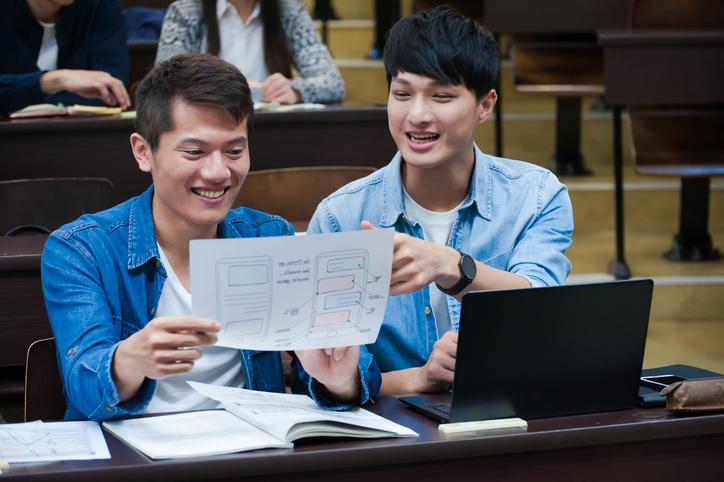
How to use humour to boost student understanding and foster creativity
Humour is a versatile teaching tool, explains Pete Ludovice. It’s fun, it makes the lecturer seem more approachable, helps make complex concepts relatable, shifts cognitive load, and encourages innovation in the classroom
Key Details
This video covers:
01:57 Using humour to make complicated ideas relatable to students
04:48 Why relatable examples help students learn
06:26 How improv can boost creativity and problem-solving
Transcript
Very good evening, ladies and gentlemen. How you doing? My name is Pete Ludovice, and like most comedians, I have a day job. My day job for the last 30 years was teaching chemical engineering at Georgia Tech. I got a lot of friends who are comedians. Whenever they tell me: “Pete, hey, I’ve quit my day job. I’m doing comedy full time”, I think we all know what that means: weed dealer.
And the big advantage of having humour in the classroom is it makes it more fun. You’re more relatable. What that translates into is something called instructor immediacy, and that’s something you really lose out on, particularly when you teach an online course like many of us did during the recent pandemic. So humour can improve instructor immediacy.
A lot of instructors think it can reduce stress, and that’s how they use it in the classroom, particularly at test time. Most of the studies on that indicate it’s not statistically significant, but I think there may be something there.
Now the beauty is you don’t have to be a comedian to bring humour into the classroom. It doesn’t necessarily help me. I come in for that 8 o’clock thermodynamics class, where the students don’t want to be there, sometimes I don’t want to be there. I tell a joke, and what do my students do? They write it down. I’m not kidding. Right. There’s always some smart-arse, and the first day he raises his hand and asks: “Is that going to be in the final exam?” So I’d like to give him a little guidance, right? I tell him if it’s got a formula in it, probably will be on the final. If it’s got a punchline in it, probably won’t be on the final. But if it has a lot of yelling, screaming and swearing, could go either way. So you don’t have to be a comedian to bring humour in the classroom.
And Ronald Burke has written on this extensively. It turns out that if you can take just sort of popular-culture issues and merge them with your academic lesson, that contrast itself is already funny. My favourite example of this is introduce your class, or a lesson they’re in, using that scrolling animation from the Star Wars films. It’s absolutely hilarious. You should try it.
The way we use it in our research, particularly with engineering and STEM lessons, is to replace a complicated technical example with one that occurs in your everyday life, a very relatable one. And the mere fact that you’re applying advanced analysis and differential equations to an everyday problem already makes that funny, so you get the joke automatically, and you get the benefit from humour.
The other benefit you get is that it changes the distribution of the cognitive load of the student as they’re trying to solve that problem. So there are many components to the cognitive load, the amount of brain power you have to use to solve a particular problem.
The first is the intrinsic load. That refers to how complicated the problem is. If it’s a complicated problem, it is a high intrinsic load. If it’s too complicated, you need to break it up into pieces.
But if that intrinsic load is high, it takes away from the germane load, which is the part of brain power you use to understand the pattern by which you solve that problem. That’s how we learn. So if it’s too complicated, you don’t have enough germane load to learn the material.
Even worse, a lot of STEM teachers and engineering teachers like to add additional technical details to make it realistic. And in fact that adds extraneous cognitive load to the picture, which even makes it worse. So you have less cognitive load left over for that germane part. So that’s really bad, and in fact in educational research, that’s called the seductive detail effect. We add in those details that we think make it seem more realistic, but in fact it just makes it more confusing.
So what we suggest is you replace this complicated problem that makes you tempted to add all these extraneous details with something relatively easy. So instead of looking at the heat transfer in a chemical reactor, talk about heating up a hot tub. Students can relate to that. It’s very relatable. Any other details you add aren’t extraneous because they’re familiar with how hot tubs work. It’s pretty easy.
Another good example that we actually studied in the classroom is when you have two different liquids that are immiscible. They don’t mix together. And you want to make them mix by adding a third liquid. The way chemical engineers study this is with this triangular-shaped ternary phase diagram that is very confusing, and the thermodynamics of the fluid miscibility is very complex. It’s not a good system to use, but if you explain it in terms of boys and girls in a middle-school dance and they kind of phase separate because they’re always at opposite ends of the gym. You add a third component – that would be adult chaperones – who come in there, grab them, push them across the gym, and say: “Get over there and talk to those people”, then you see how it becomes more miscible.
We did exactly that relatable problem to teach these ternary phase diagrams, and it turns out it actually works. It increases the germane cognitive load and students learn better. The good thing about it is when you eventually go to the complex problem, you can actually see the students solve that one better as well.
We observe that in the classroom, because this is something called isomorphic knowledge transfer. The structure of the sort of, you know, relatable problem and the real problem are the same. They’re isomorphic. So in fact the mathematics works the same, the concepts work the same.
A good example of that is something I do in a numerical methods class, where I take my favourite TV show. It’s called Bar Rescue, with this crazy guy named Jon Taffer, who comes in and uses “bar science” to fix failing bars. And clearly bar science is something the average undergraduate can really relate to.
And he mentioned this thing called a butt funnel, and it sounds dirty, that you know you have to go look it up in the Urban Dictionary, but in fact it is putting a bar rail with a space in it between the dance floor and the bar that’s the width of 1.5 average people. That means if you want to go back and forth, you either have to squeeze by someone or stop and say “Excuse me” and talk to them and interact with them. It increases interaction. They’re more likely to meet. They’re more likely to stay. They’re more likely to buy drinks.
So in fact the differential equations that describe how that works, how many people actually meet, are exactly the same as two or more species reacting in the pores of a mesoporous catalyst structure, and that’s a much more complicated problem.
But the bar problem is something the average undergraduate can relate to. The mathematics are the same, so they are in fact isomorphic, and literature indicates that this isomorphic transfer is something that happens very easily.
So I’m actually on leave now at the University of Alabama, where I’m trying to help them start their engineering entrepreneurship programme, and in fact you can use humour to help with creativity. So this has been used for years on Madison Avenue to help people design marketing campaigns. What we do is we do humorous improv to generate random crazy ideas, and then we use those ideas to sort of spur possible solutions to an engineering design problem. And we’ve actually designed some really unique engineering solutions by doing that.
It’s basically a Monte Carlo model, but instead of a random number generator to pick the state of the system, you’ve got this random humour that then is used to generate possible solutions. We do these workshops all over the country, and we’re doing them now at the University of Alabama.
We’re actually using artificial intelligence to see if we can convert the whole process to an app – but trust me, the humorous improv workshop is a heck of a lot more fun.
So, in short, basically humour is good for the classroom because it’s fun, it’s relatable. We see that in advertising and marketing campaigns all the time. And it increases instructor immediacy. That’s particularly good for online classes, where instructor immediacy is a difficult thing to achieve. A lot of people believe it reduces stress in the classroom.
You don’t have to be a comedian to do it. You can take a pop culture reference, mix it with your academic lesson to generate the humour. You can also generate that humour automatically by replacing a complicated example with a high amount of extraneous cognitive load and intrinsic cognitive load with a relatable example, so that increases the germane cognitive load and helps the student learn it better. And as long as they’re structurally similar, you have isomorphic transfer, so they can solve the real problem there as well.
And finally you can also use it to help with creativity and innovation if you have an entrepreneurship programme like the one we’re trying to start here at the University of Alabama.
Now you have to consider the appropriateness of the humour. A lot of times people think: “Oh, the joke’s not right; it’s inappropriate.” But when you consider that, understand this: that if a PhD says it, it’s not a dirty joke, it’s educational. And that’s my time, ladies and gentlemen. I’ll be here all week. Try the veal.
Pete Ludovice is executive director of the engineering entrepreneurship programme at the College of Engineering at the University of Alabama and an affiliate of the Center for 21st Century Universities (C21U) at Georgia Tech.



